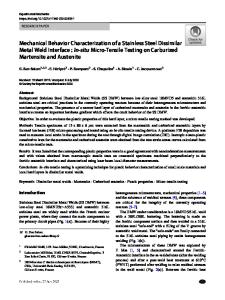Characterization of Mechanical and Metallurgical Notch Effects of DP980 Steel Weld Joints in Fatigue Performance
- PDF / 16,135,365 Bytes
- 14 Pages / 593.972 x 792 pts Page_size
- 93 Downloads / 464 Views
ODUCTION
DUAL-PHASE (DP) steel, a type of advanced high-strength steel (AHSS), is increasingly employed in structural components of automobiles to reduce vehicle weight while enhancing crashworthiness.[1–4] This type of steel is favored because of its good processability and its balanced combination of strength and ductility.[3–8] This excellent performance arises from DP steel’s microstructural characteristics, namely a soft ferrite matrix containing hard martensite islands formed by means of low-temperature phase transformation during cooling from intercritical annealing conditions.[5,6] In the automotive industry, the most commonly used DP steel grades are of 590 and 780 MPa tensile strength.[7–14] Thus, higher-grade steels such as DP980 are expected to provide decreased weight as automotive parts, by allowing reductions in thickness without loss of strength.[3,15–20]
GITAE PARK and CHANGHEE LEE are with the Division of Materials Science and Engineering, Hanyang University, Seoul, 04763, Republic of Korea. Contact e-mail: [email protected] GYUYEOL BAE is with the Welding & Joining Research Group, POSCO, Pohang, 37859, Republic of Korea. Manuscript submitted August 6, 2018.
METALLURGICAL AND MATERIALS TRANSACTIONS A
Regarding the joining of automotive steels, pulsed gas metal arc welding (P-GMAW) is the main process used owing to its acceptable weld strength for chassis and underbody components, with reliable welds, versatility, and speed.[21] Factors affecting these arc-welded joint performances are residual stress, toe geometry, microstructures, and the mechanical properties in each region.[4,7] Among these, residual stress and toe geometry are related to the formation of the fusion zone (FZ), and can be resolved or controlled by using a low-temperature transition (LTT) wire using the expansion during phase transformation from austenite to martensite. Many experimental results[22,23] indicate that improvements of fatigue performance in weldments can be achieved through control over the martensitic transformation. On the other hand, the characteristics in each heat-affected zone (HAZ) are affected by the intrinsic properties of the steel and/or the weld heat input. What is important to consider here is how the existing martensite in steel sheets is transformed during the unavoidable welding thermal cycles. Furthermore, the greater strength of the DP steel used, the more metallurgical and mechanical variation of characteristics in the HAZ[7,15,16]; e.g., maximum amount of HAZ softening is relative to volume fraction of hard phase,[16] so that this makes it difficult to ensure reliable weld performance in higher-grade DP steels. Understanding the variations of phase transformations in each HAZ
Table I.
Chemical Compositions of DP980 Base Metal and Filler Metals [Weight Percent]
Type
Fe
C
Mn
Si
S+P
Ti
Nb
Base Metal Solid Wire Flux-Cored Wire
bal. bal. bal.
0.08 0.05 0.14
1.95 1.37 1.65
1.50 0.51 1.12
< 0.008 < 0.008 < 0.014
0.005 — 0.065
0.030 — 0.012
region is therefore necessary to widen the pr
Data Loading...











